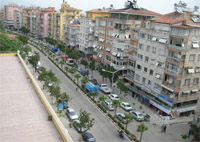 Modern Antakya. Image from Asaf Aynur. |
Last year BeyondDC ran a story about Tayasal, a Mayan city that survived until almost 1700. Obviously the story had nothing to do with urbanism in Washington, DC; it was just a tidbit of urban history that I found fascinating. I said more such stories would appear from time to time, under the History of Cities tag. Here’s number 2.
Antioch was at its height the second largest city of the Roman Empire, after Rome itself. It may have had a population of up to 600,000, and was the chief metropolis of the Near East for centuries, through the late ancient world and into the early middle ages.
I’ve always been curious about Antioch. Why didn’t it survive into the modern era, as its peers Rome, Alexandria, Constantinople, and Damascus did? There is a modern city on the same site in today’s Turkey, Antakya, but it is a totally different place, and its modern population of 200,000 is a fraction of its ancient size.
Antioch survived the fall of Rome and remained an important city under the Byzantine Empire into the Crusader Era, before finally being abandoned around 1400. Its long decline lasted almost 1,000 years, and probably began with the silting of its port around 500 CE. The city was on the front line of the wars between Christianity and Islam, and changed hands multiple times over hundreds of years. It finally died after the Mongol Empire’s invasion resulted in a dramatic depression of Middle Eastern civilization in general, and the end of the Islamic Golden Age.
January 23rd, 2012 | Permalink
Tags: History of cities













